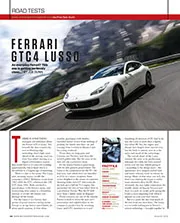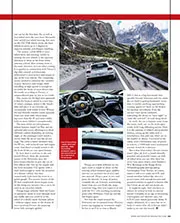

Ferrari GTC4 Lusso
An everyday Ferrari? This one is getting perilously close… | by Joe Dunn There is something strangely old fashioned about the Ferrari GTC4 Lusso. Yes, beneath the skin it packs…
Few racing cars have enjoyed such long and successful careers as Lola’s T300 series. What started out as a world-beating Formula 5000 open-wheeler in 1971 outlived the cars that were meant to replace it, and the design was still a winner as a sports car of sorts deep into the 1980s.
Not bad for a car that had its roots in a throwaway remark on an aeroplane journey in June 1971. Frank Gardner made the suggestion to Lola boss Eric Broadley, on the way back from Monza, and the idea took hold. The plain-speaking Aussie reckoned that putting a five-litre Chevrolet V8 in the back of the British constructor’s T240 Formula 2 car might offer an improvement over the existing T192 and boost his chances of winning the Rothmans European F5000 Championship.
Gardner turned out to be right. The car was ready in time for the Thruxton round in August and was on the podium first time out. In fact, Gardner never finished off the podium in his new works-run car over the remainder of a season in which he notched up three wins on the way to the title.
“It was definitely Frank’s idea,” recalls Bob Marston, who ran the Lola design office under Broadley throughout the 1970s. He describes the T190/192, the first monocoque F5000 Lolas that had evolved out of the T140 of 1968 vintage, as a “bit of a heavy old car”.
But the T300 was always a compromise, says Marston, and it failed to repeat Gardner’s title success. Lola took on the lessons and came up with the T330 for 1973.
The chassis was new and the design incorporated a series of upgrades, including using the big V8 as a stressed chassis member, but the car kept the family look defined by the distinctive side-mounted radiators. These were dubbed “elephant ears”, though Marston can’t remember who coined the phrase.
“The T332 of 1974 began a purple patch for Lola in F5000 and beyond”
The T330 was a race winner in both Europe and in the L&M cigarettes-sponsored North American series, although championship success again eluded it. Jody Scheckter did, however, twice race a T330 instead of his regular Trojan on his way to winning the Stateside series.
The T332 of 1974 was a further refinement and began a purple patch for Lola in F5000 and beyond. The car was unbeaten in North America, Brian Redman taking the title in a car run by Lola importer Carl Haas. Bob Evans, meanwhile, triumphed for Alan McKechnie Racing in the European series.
Redman would go on to score a hat-trick of US titles, although in Europe the championship went to a new Lola, the T400. VDS Racing was one of the few teams to get a handle on a car that incorporated rising rate suspension, but the T330/332 still won races with those that couldn’t.
That explains why Lola offered a ‘C-spec’ T332 alongside a T400 update for ’76. And why, when the organisers of the North American series decided to revive Can-Am by clothing F5000s in all-enveloping bodywork, Lola used the T332 as the base.
The T332CS and T333CS took a hat-trick of titles with Patrick Tambay, Alan Jones and Jacky Ickx from 1977 through ’79. But that wasn’t the end of the T300 story. The design formed the base of many Can-Am specials, most famously the Frissbees in which Al Unser Jr and Jacques Villeneuve Jr claimed title successes. Veteran Horst Kroll won the final Can-Am crown in 1986, driving a Frissbee that was in fact a T332 below the surface – the second one delivered.
LOLA T300/330/332
• Price new N/A
• Price now £120,000-£160,000
• Engine 5-litre Chevrolet V8
• Power 500bhp-plus
• F5000 championship race wins 31 (USA), 28 (Europe)
• Verdict The definitive F5000 racer that evolved into a successful second career in single-seater Can-Am
If you want an F5000 Lola, look Down Under
Due to the international nature of the events in which the T300-series Lolas competed, the market is widespread. Of the known remaining examples, only a handful are thought to reside in the UK, with most cars now located across North America, Australia and New Zealand.
That isn’t too surprising, as Australia was the last country to drop F5000, at the end of 1981, and the category has regained momentum via the Antipodes-based Tasman Cup Revival Series, run continuously since 2003.
There is no recent auction data to indicate any emerging price patterns and public sales appear few and far between. In May 2018, T332 chassis HU32B was listed for sale in America for the equivalent of £125,000. And in New Zealand, T332 chassis HU16 was advertised for NZD$275,000 (£140,000 at the current rate), though the date of the listing is unclear. The previous owner competed in the Tasman Cup Revival Series in 2013.
With New Zealand being the home of historic F5000 racing, it seems logical that market activity should centre around Australasia. As such, T330/T332 sales are rare in the UK and price fluctuations could result just as easily from exchange rate movements as market demand.
Robert Johnson, Classic and Sports Finance
